[1]
CAI Jun, HUANG Rong-fu, WANG Wei. On Prevention and Treatment Measures of Ship s Oil Overflow[J]. Ship & Ocean Engineering, 2010, 39(2): 108-110.
Google Scholar
[2]
[ZHANGZheng, CHENGShiyong, LIHan, An C.F. Preliminary numericalsimulation of boom failure with VOFmodel [J]. ACTA SCIENTIAE CIRCUMSTANTIAE, 1999, (6): 604-609.
Google Scholar
[3]
YU Gui-feng, WU Wan-qing, FENG Xing. Numerical experiment on applicable conditions of typical oil boom based on the software Fluent[J]. Journal of Dalian Maritime University, 2010, 36(2): 117-120.
Google Scholar
[4]
Ning Cheng-hao, Numerical Simulation of Boom Failure[D]. Beijing: Beijing University of Chemical Technology, (2002).
Google Scholar
[5]
Wei Fang. Oil Booms in Various Sea States Blocked Oil and Shape Optimization of Numerical Simulation[D]. Dalian: Dalian Maritime University, (2007).
Google Scholar
[6]
LIU Cheng; SHEN YongMing , LIANG Yan. Relationship between pressure gradient along the boom and the instability of oil-water interface[J]. Scientia Sinica(Physica, Mechanica & Astronomica). 2011, 41: 170–177.
DOI: 10.1360/132010-763
Google Scholar
[7]
DELVIGINE G A L. Laboratory experiments on oil spill protection of a water intake[J]. Monograph: Oil in Freshwater, 1985: 446-458.
DOI: 10.1016/b978-0-08-031862-2.50037-x
Google Scholar
[8]
BROWN H M, GOODMAN R H, CHANG F A, et al. Boom failure mechanism: Comparison of channel experiments with computer modeling results[J]. Spill Science & Technology Bulletin, 1996, 3(4): 217-220.
DOI: 10.1016/s1353-2561(97)00016-9
Google Scholar


